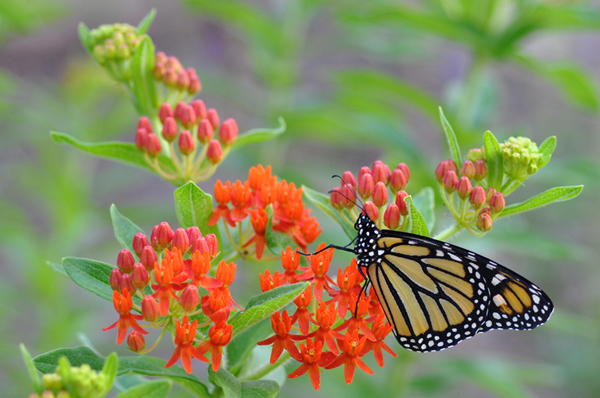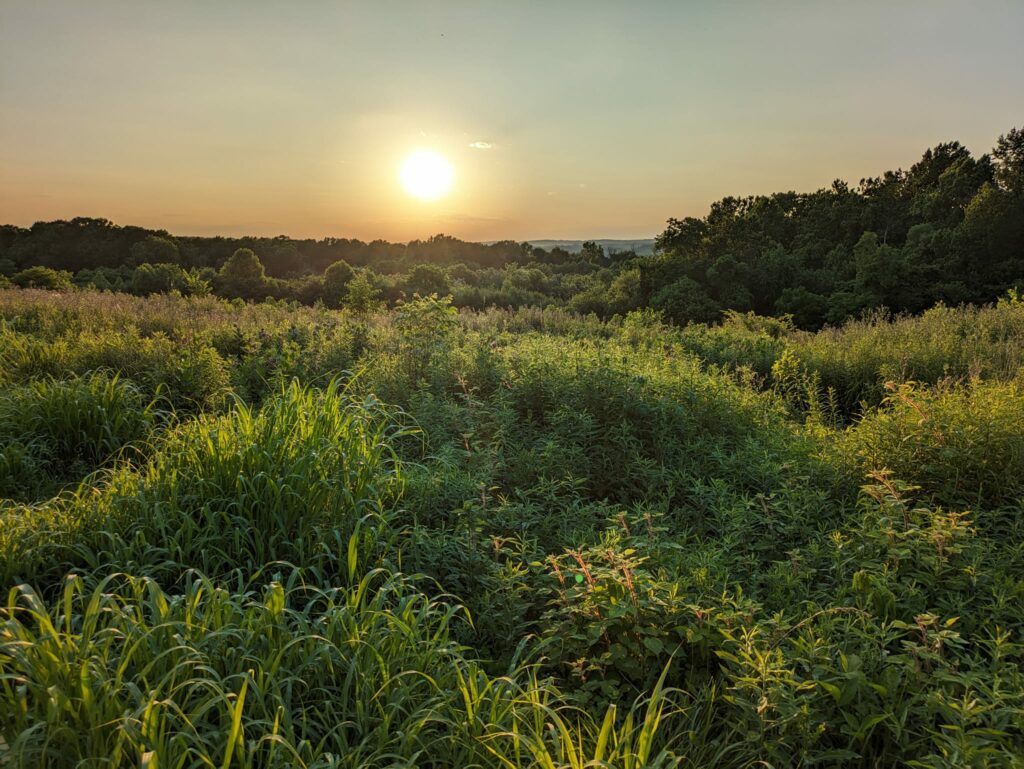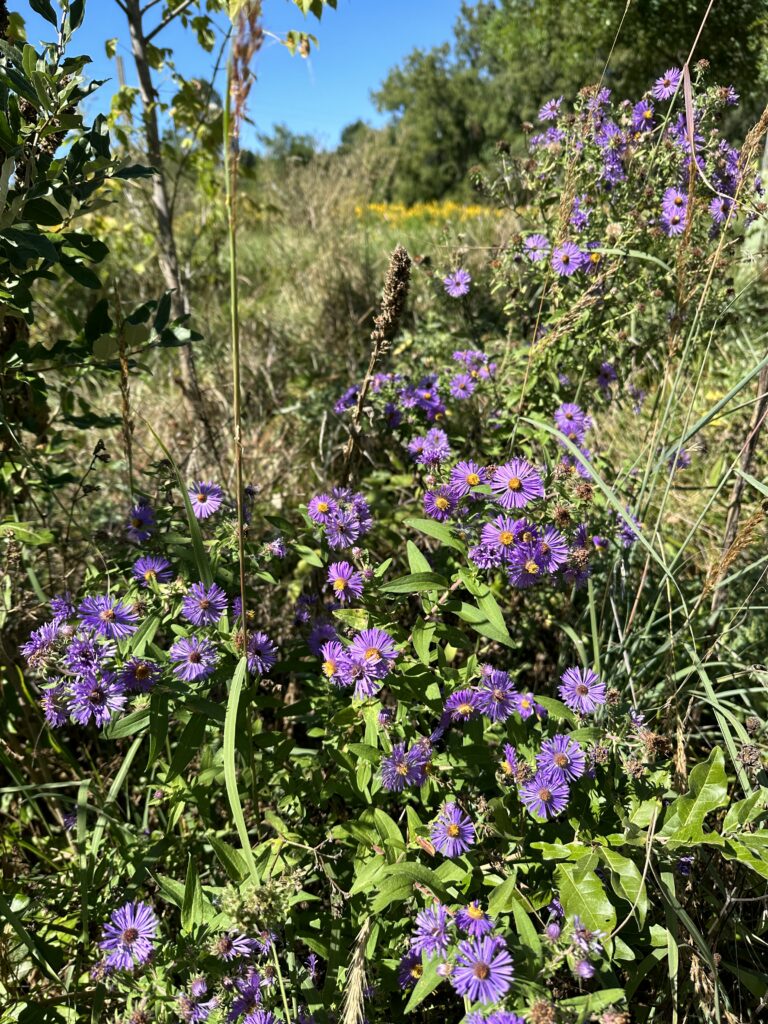By Keith Williams, Vice President of Engagement & Education, and Eric Roper, Forester
The wind hisses through the big and little bluestem grasses, bends the mountain mint, and sends waves of green and shiny silver through the field to the horizon. A flash of orange flits across the trail and lands on a purple bee balm blossom. This monarch was brand new – recently emerged from his chrysalis, where his caterpillar body was biochemically completely rearranged into an adult winged one which led to his completely new life, from an earth-bound juvenile to an aerial adult. Monarchs are struggling. Their population declined 50% in the last year.

Monarch on butterfly weed
Monarchs are migratory. Generation 1 starts on the mountains of central Mexico and migrates to about the Texas line, where they have babies and die. Generation 2 travels a bit further north where they have babies and die. Generation 3 does the same, and births generation 4. And this clean, unscathed, new-to-the-air monarch was the most recent addition who will make the 3,000-mile flight back to Mexico. How will he know how to do that, when he is four generations removed from his ancestors who left five months ago? This is one of the many meadow mysteries.
This magical place, a native eastern meadow, is one of the rarest ecosystems on the planet now, but they were common before European settlement. The misperception is that this region was covered in eastern deciduous forest. But the reality was that ecological disturbance – grazing and fire – kept large patches of our landscape in early successional habitats like meadows and grasslands for the last 15,000 years, and meadows were abundant here up until 200 years ago.
So where did the meadows go?
Left undisturbed, seeds from adjacent forests sprout and grow, ultimately changing meadow to forest. This is called succession. It’s the progression of ecosystems until they reach a steady state called a climax ecosystem. But disturbance can prevent a climax ecosystem from developing, allowing earlier successional stages to prevail. A healthy landscape is a patchwork of systems in different stages of succession.

Clark Nature Preserve meadow with forest in the background (Photo by Peggy Eppig)
One of the ways European settlers altered the landscape was by eliminating the ecological disturbances that maintained gaps in the forest. Dry lightning strikes ignited fires. Native people used fire as a management tool. Aggressive fire suppression and the removal of Native people from the landscape also removed this important ecological disturbance. Large mammals, like eastern woodland bison and elk, used to graze the sprouting trees out of the meadows. They were hunted out of our region, and the eastern bison was extinct by 1815.
Additionally, meadows and grasslands were the easiest to develop into farm fields, and farm fields were the easiest to develop into towns, cities, and suburbs. All of this contributed to the rarity of native eastern meadows and grasslands today. We stabilized their disturbance regimes and developed them out of existence.
Besides being historical fixtures of this landscape, meadows are ecologically significant. They provide a more stable carbon storage than forests because 90% of their carbon is stored below ground in root matter, whereas most of the forest’s carbon is stored in above ground vegetation. The deep root systems of grassland plants that provide stable carbon storage also act as sponges, helping rainwater soak into the ground and recharge groundwater, rather than running over land and carrying muddy water into streams.
Meadows are biodiversity hot spots and support a large number of plants, insects, birds, reptiles, and mammals. They are the homes of organisms that provide critically important services to us, like pollination.
Although meadows may be disappearing, there are steps we can take to restore them.
Beginning in 2021, Lancaster Conservancy engaged with the Natural Resources Conservation Service and Pheasants Forever to develop plans to convert fields at Safe Harbor, Kellys Run, Tucquan Glen, and Wizard Ranch into warm season grass pollinator meadows. Restoration timelines are often long, but in April 2024, we drill seeded the first fields at Kellys Run Nature Preserve. The seed mixtures, designed specifically for these sites in consultation with our partners, are tailored to provide crucial habitat for imperiled species including monarchs, American bumblebee, regal fritillary, and frosted elfin.

Kellys Run Nature Preserve meadow (Photo by Rachel Haynes)
Once a meadow is established, it is imperative to manage fast-growing invasive species that can outcompete desirable meadow species. Invasive species are typically introduced into a new area from their original ecosystem – often their original ecosystem is on another continent – which means the typical population controls like diseases and predation (or herbivory) aren’t there to keep their numbers in check. Their populations can grow exponentially, and they outcompete native organisms for resources like food, water, sunlight, and nutrients. Their overall effect is a reduction in biodiversity.
Depending on the species, once an invasive plant is allowed to establish itself within a meadow and produce seed, the seedbank from that plant can sit dormant in the soil for up to seven years, meaning any efforts to control the establishment and spread of the invasive species can last for up to seven years (and that is assuming that, over that timeframe, control efforts are sufficient to prevent the dispersal of additional seed).
In addition to the management of invasive species, successful meadow management also sometimes means managing species that would be desirable in a different habitat type, such as young stems of sycamore, tulip polar, and black locust. Left to their own devices, these pioneer forest species will seed into a meadow in the process of ecological succession. Left alone, these woody species will expand and begin to change ecological interactions as the meadow begins to transition into an early successional woodland. While both have their benefits, meadows and early successional woodlands provide different ecological services. The control of woody stems can be accomplished using a variety of methods including cutting, prescribed mowing, and prescribed fire.
Lancaster Conservancy is working to support healthy meadows at nature preserves including Clark, Kellys Run, and Donegal Highlands.

 It's here – the Water Week 2025 T-shirt! Wa
It's here – the Water Week 2025 T-shirt! Wa






